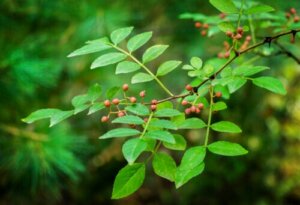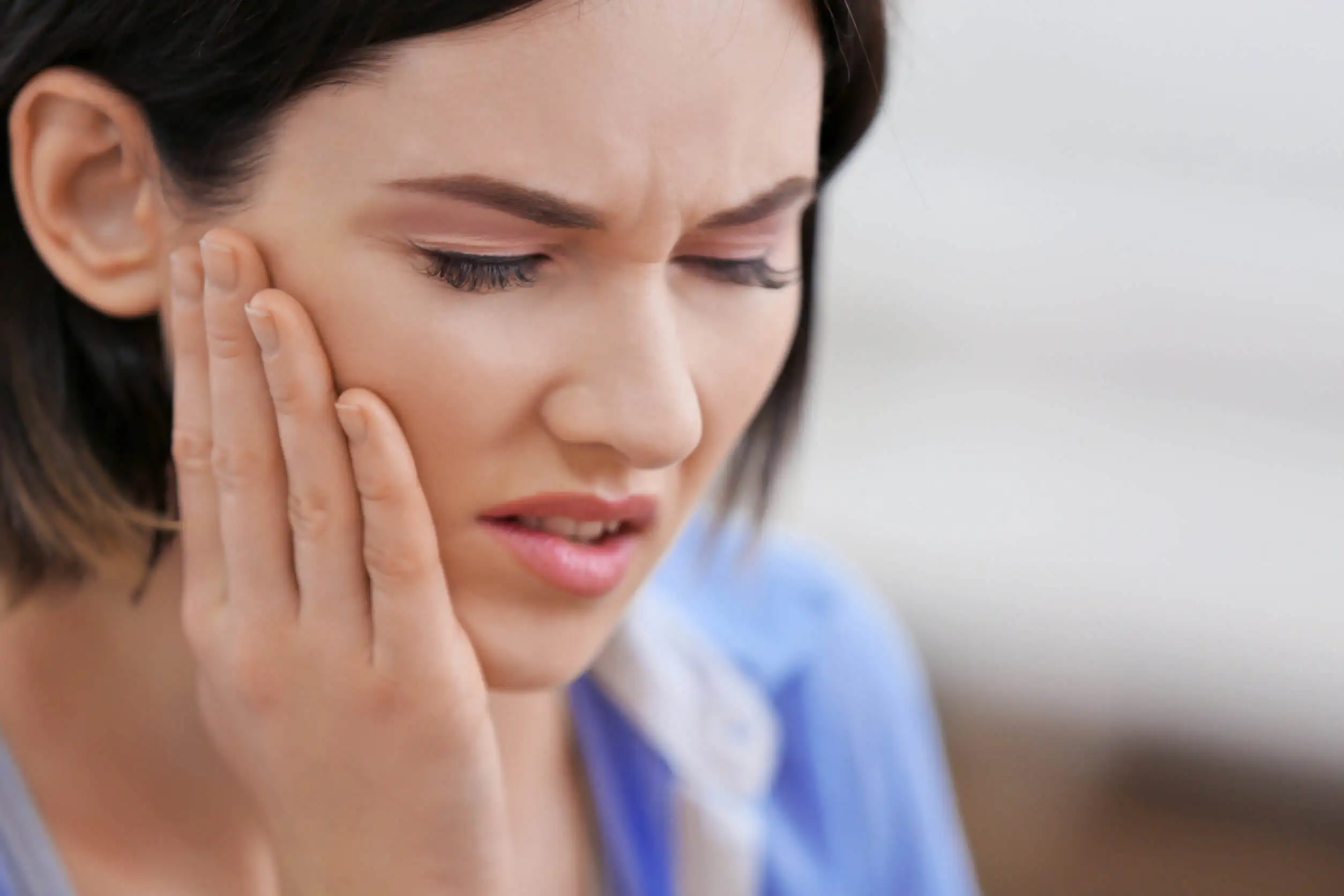Prickly Ash: What Are its Medicinal Uses?


Reviewed and approved by the pharmacist Franciele Rohor de Souza
The prickly ash (Zanthoxylum clava-herculis) is a shrub that belongs to the Rutaceae family. It has brown thorny branches, as well as dark green leaves that stand out for their penetrating aroma. Its axillary clusters give off greenish-yellow flowers and small fruits that change from green to reddish-brown when ripe.
Although it’s native to the United States, it usually grows in damp ravines, thickets, and forests in Canada and Europe. But, regardless of its origin, it’s often distributed as an herbal supplement for the relief of ailments, infections, and circulatory disorders. What are its properties and applications?
What are the medicinal uses of prickly ash?
Prickly ash has a long history as a traditional remedy, with multiple properties attributed to it.
According to an article reported in Frontiers in Pharmacology, this is largely due to its content of alkaloids, flavonoids, terpenoids, and lignans. These, in turn, confer antibacterial, antifungal, antiviral, anti-inflammatory, and antioxidant activity.
While its bark and leaves are often used in tea form, it’s also available in capsules, extracts, tinctures, and powder. Its fame as a supplement is often linked to positive effects on joint, dental, and circulatory health.
However, the evidence is still limited.
Like other herbal remedies, this ingredient should be used with caution, only as a supplement. There aren’t enough studies to claim that it serves as a first-choice treatment.
Folk literature notes that Native American tribes used prickly ash to treat muscle ailments, lung conditions, colds, and fevers. Over time, it was also found to have positive effects against cholera, toothache, and typhoid fever. But what does science say?

Research on prickly ash
The international journal Molecular Sciences details that at least 140 bioactive compounds have been identified in prickly ash. Among these, alkaloids, terpenoids, flavonoids, and free fatty acids are the most prominent. Hence, it’s linked to several health benefits.
According to this publication, both extracts and compounds of this plant have biological activity as anti-inflammatory, analgesic, antioxidant, antibacterial, and antitumor agents. This would explain its uses in traditional herbal medicine, which include the following:
- As an anti-nausea agent
- As an antifungal remedy
- As an antirheumatic remedy
- As a stimulant of blood and lymphatic circulation
- For digestive disorders (abdominal pain, diarrhea, among others)
However, many of these uses haven’t been validated by current research.
Researchers believe that more clinical trials are needed to determine the relationship between the plant’s chemical compounds and their effects. Also to establish its safety profile and new clinical applications.
For now, only an in vitro study shared through the Journal of Traditional and Complementary Medicine reported that prickly ash has antifungal properties, useful against Aspergillus flavus and Trichophyton longifusis. Thus, it could benefit the treatment of mild fungal infections.
Meanwhile, an article reported in Natural Product Communications comments that the volatile oils of prickly ash promote better blood circulation by stimulating the dilation of veins. This is explained by its alkaloid content.
As for its antitumor qualities, the evidence is very limited. A test tube study shared in Phytotherapy Research reported the cytotoxic effects of prickly ash and its ability to inhibit human leukemia cells. However, more research is needed.
Risks and safety
Given the lack of studies, no serious side effects are described for the use of this shrub. However, it’s advisable to moderate its consumption and limit doses to what is suggested by the supplement manufacturer.
In excess, liver toxicity and anaphylaxis may result. Some warning symptoms are the following:
- Dizziness
- Urticaria
- Chest pain
- Difficulty in breathing
- Altered heart rhythm
- Swelling of the throat or tongue
In the presence of these clinical manifestations, emergency medical consultation is essential. However, it can happen only in rare cases.
Other contraindications are the following:
- Pregnancy and lactation
- Renal or hepatic insufficiency
- People under treatment with anticoagulants or diuretics

Dosage and preparation
At present, there are no defined guidelines for the use of prickly ash. Supplements often suggest dosages of 400 milligrams per day.
However, this may vary by manufacturer and product type. Therefore, it’s necessary to consult the label.
The bark and powder are often used in teas. It’s enough to add half a teaspoon of the powdered product (3 grams) to a cup of boiled water. It can also be prepared in decoctions for topical use as a compress. This last option is often a traditional remedy for muscle and joint pain.
Be sure to read: Nine Herbs and Spices to Help Purify Your Blood
What you should remember about prickly ash
Prickly ash is a shrub native to North America. It’s valued for its abundant content of bioactive compounds, including alkaloids, terpenoids, flavonoids, and fatty acids. These are believed to exert anti-inflammatory, anti-rheumatic, anti-tumor, and digestive effects.
However, at present, there’s insufficient scientific evidence to support its applications. Most of its uses are explained in a traditional way and not with scientific validity. Therefore, like other medicinal herbs, it should be used with caution, only as a supplement, and preferably under medical supervision.
All cited sources were thoroughly reviewed by our team to ensure their quality, reliability, currency, and validity. The bibliography of this article was considered reliable and of academic or scientific accuracy.
- Okagu IU, Ndefo JC, Aham EC, Udenigwe CC. Zanthoxylum Species: A Review of Traditional Uses, Phytochemistry and Pharmacology in Relation to Cancer, Infectious Diseases and Sickle Cell Anemia. Front Pharmacol. 2021 Sep 15;12:713090. doi: 10.3389/fphar.2021.713090. PMID: 34603027; PMCID: PMC8479109.
- Zhang, M., Wang, J., Zhu, L., Li, T., Jiang, W., Zhou, J., Peng, W., & Wu, C. (2017). Zanthoxylum bungeanum Maxim. (Rutaceae): A Systematic Review of Its Traditional Uses, Botany, Phytochemistry, Pharmacology, Pharmacokinetics, and Toxicology. In International Journal of Molecular Sciences (Vol. 18, Issue 10, p. 2172). MDPI AG. https://doi.org/10.3390/ijms18102172
- Bhatt, Vinod & Sharma, Sushila & Kumar, Neeraj & Sharma, Upendra & Singh, Bikram. (2017). Chemical Composition of Essential Oil among Seven Populations of Zanthoxylum armatum from Himachal Pradesh: Chemotypic and Seasonal Variation. Natural product communications. 12. 1643-1646. 10.1177/1934578X1701201030.
- Alam, F., & us Saqib, Q. N. (2017). Evaluation of Zanthoxylum armatum Roxb for in vitro biological activities. In Journal of Traditional and Complementary Medicine (Vol. 7, Issue 4, pp. 515–518). Elsevier BV. https://doi.org/10.1016/j.jtcme.2017.01.006
- Ju, Y., Still, C. C., Sacalis, J. N., Li, J., & Ho, C.-T. (2001). Cytotoxic coumarins and lignans from extracts of the northern prickly ash (Zanthoxylum americanum). In Phytotherapy Research (Vol. 15, Issue 5, pp. 441–443). Wiley. https://doi.org/10.1002/ptr.686
This text is provided for informational purposes only and does not replace consultation with a professional. If in doubt, consult your specialist.








